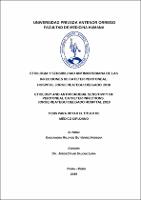Mostrar el registro sencillo del ítem
Etiología y sensibilidad antimicrobiana de las infecciones de catéter peritoneal. Hospital Jorge Reategui Delgado 2018
| dc.contributor.advisor | Salome Luna, Jorge David | |
| dc.contributor.author | Gutiérrez Heredia, Kassandra Mildred | |
| dc.creator | Gutiérrez Heredia, Kassandra Mildred | |
| dc.date.accessioned | 2019-08-13T22:34:47Z | |
| dc.date.available | 2019-08-13T22:34:47Z | |
| dc.date.issued | 2019 | |
| dc.identifier.uri | https://hdl.handle.net/20.500.12759/5284 | |
| dc.description.abstract | La región Piura ocupa el tercer lugar a nivel nacional en insuficiencia renal crónica (IRC). La cantidad de personas con IRC sometidas a diálisis peritoneal (DP) es creciente y la principal complicación de ella es peritonitis infecciosa. En Piura no se tiene un estudio sobre los agentes bacterianos en peritonitis asociada a DP y su susceptibilidad. OBJETIVO: Determinar la etiología y sensibilidad antimicrobiana de las infecciones de Catéter peritoneal. Hospital Jorge Reátegui Delgado 2018. MATERIAL Y MÉTODOS Todos los pacientes en DP durante el año 2018, que cuenten con resultado de cultivo de líquido peritoneal y cumplan los criterios de selección. Estudio descriptivo, transversal, retrospectivo, de fuente secundaria. RESULTADOS. El programa DIPAC (Diálisis Peritoneal Crónica Ambulatoria) durante el tiempo que se realizó el presente estudio, registró 107 pacientes en DP, de los cuales 27 de ellos presentaron peritonitis; dentro de este grupo 23 pacientes tuvieron un solo episodio de peritonitis, 3 pacientes presentaron dos episodios y 1 paciente presentó 4 episodios, haciendo un total de 33 casos, representando una incidencia de 30.84% del total de usuarios de DP. El 45.45% son de sexo masculino; la edad promedio fue 57.03 años. La comorbilidad más frecuente fue hipertensión arterial (78.78%). Los agentes bacterianos involucrados en los casos de peritonitis que presentaron los pacientes de esta investigación fueron Pseudomona aeroginosa (24.2%), Staphylococus epidermidis (21.2%) y Escherichia coli (15.2%). Los microorganismos que fueron resistentes a todos los veintidós antibióticos a los que fueron expuestos, son: streptococus salivarius, micrococus y estreptococo anginosus. La vancomicina y las quinolonas son los antibióticos que a los que menos resistencia presentan los gérmenes aislados. CONCLUSIONES. En el hospital Jorge Reátegui Delgado se sugiere iniciar antibiótico terapia empírica en pacientes con peritonitis asociada a DP con vancomicia más levofloxacino o vancomicina más gentamicina, hasta que se identifique el agente infeccioso y su resistencia por ser bacterias exigentes. | es_PE |
| dc.description.abstract | The Piura region ranks third in the country in chronic kidney failure (CRI). The number of people with IRC undergoing peritoneal dialysis (DP) is increasing and the main complication of this is infectious peritonitis. Piura does not have a study on bacterial agents in peritonitis associated with DP and its susceptibility. OBJECTIVE: To determine the etiology and antimicrobial sensitivity of infections of peritoneal catheter. Hospital Jorge Reátegui Delgado 2018. MATERIAL AND METHODS All patients in PD during the year 2018, who have a result of culture of peritoneal fluid and meet the selection criteria. Descriptive, transversal, retrospective, secondary source study. RESULTS The DIPAC program (Chronic Ambulatory Peritoneal Dialysis) during the time this study was conducted, registered 107 patients in PD, of which 27 of them had peritonitis; Within this group 23 patients had a single episode of peritonitis, 3 patients presented two episodes and 1 patient presented 4 episodes, making a total of 33 cases, representing an incidence of 30.84%. The 45.45% are male; the average age was 57.03 years. The most frequent comorbidity was hypertension (78.78%). The bacterial agents involved in the cases of peritonitis presented by the patients of this investigation were Pseudomonas aeroginosa (24.2%), Staphylococcus epidermidis (21.2%) and Escherichia coli (15.2%). The microorganisms that were resistant to all twenty-two antibiotics to which they were exposed are: streptococcus salivarius, micrococcus and streptococcus anginosus. Vancomycin and quinolones are the antibiotics that are least resistant to isolated germs. CONCLUSIONS: In the Jorge Reátegui Delgado hospital it is suggested to initiate antibiotic empirical therapy in patients with peritonitis associated with DP with vancomycin plus levofloxacin or vancomycin plus gentamicin, until the infectious agent is identified and its resistance because their are demanding bacteria | en_US |
| dc.description.uri | Tesis | es_PE |
| dc.format | application/pdf | es_PE |
| dc.language.iso | spa | es_PE |
| dc.publisher | Universidad Privada Antenor Orrego | es_PE |
| dc.relation.ispartofseries | T_MEDP_124 | |
| dc.rights | info:eu-repo/semantics/openAccess | es_PE |
| dc.rights.uri | https://creativecommons.org/licenses/by/4.0/ | es_PE |
| dc.source | Universidad Privada Antenor Orrego | es_PE |
| dc.source | Repositorio Institucional - UPAO | es_PE |
| dc.subject | Antimicrobio | es_PE |
| dc.subject | Peritoneal | es_PE |
| dc.title | Etiología y sensibilidad antimicrobiana de las infecciones de catéter peritoneal. Hospital Jorge Reategui Delgado 2018 | es_PE |
| dc.type | info:eu-repo/semantics/bachelorThesis | es_PE |
| thesis.degree.level | Título Profesional | es_PE |
| thesis.degree.grantor | Universidad Privada Antenor Orrego. Facultad de Medicina Humana | es_PE |
| thesis.degree.name | Médico Cirujano | es_PE |
| thesis.degree.discipline | Medicina Humana | es_PE |
| dc.subject.ocde | https://purl.org/pe-repo/ocde/ford#3.02.27 | es_PE |
| renati.type | https://purl.org/pe-repo/renati/type#tesis | es_PE |
| renati.level | https://purl.org/pe-repo/renati/level#tituloProfesional | es_PE |
| renati.discipline | 912016 | es_PE |
| dc.publisher.country | PE | es_PE |
Ficheros en el ítem
Este ítem aparece en la(s) siguiente(s) colección(es)
-
Medicina Humana [2814]


